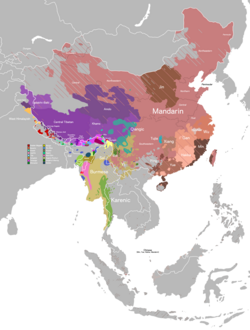You can help expand this article with text translated from the corresponding article in Chinese. (July 2015) Click [show] for important translation instructions.
|
This article includes a list of general references, but it lacks sufficient corresponding inline citations. (December 2008) |
| Changsha dialect | |
|---|---|
| 长沙话 | |
| Pronunciation | [tsã˩˧sɔ˧ɣo˨˩] |
| Native to | China |
| Region | Changsha, Hunan province |
| Language codes | |
| ISO 639-3 | – |
hsn-cha | |
| Glottolog | chan1326 |
The Changsha dialect (simplified Chinese: 长沙话; traditional Chinese: 長沙話; pinyin: Chángshāhuà; IPA: [tsã˩˧sɔ˧ɣo˨˩]) is a dialect of New Xiang Chinese. It is spoken predominantly in Changsha, the capital of Hunan province, China. It is not mutually intelligible with Standard Mandarin, the official language of China.
Classification
[edit]The Changsha dialect is what Chinese dialectologists would call a New Xiang variety, as opposed to Old Xiang; the distinction is mainly based on the presence of the Middle Chinese voiced plosives and affricates. The Old Xiang varieties, being more conservative, have in general kept them while the New Xiang ones have altogether lost them and changed them to voiceless unaspirated consonants. Although most Chinese dialectologists treat New Xiang as part of the group, Zhou Zhenhe and You Rujie classify it as Southwestern Mandarin.[1]
Geographic distribution
[edit]The Changsha dialect is spoken in the city of Changsha and its neighbouring suburbs. However, there are some slight differences between the urban and suburban speech. For instance, the retroflex set is only heard in the suburbs, but not in the city. Further, some words have a different final in the two varieties.
Dialects
[edit]There are no substantial differences between dialects in the neighbourhoods of Changsha; however, age dialects do exist. For example, the distinction between alveolar and alveolo-palatal consonants is only made by the elderly while the younger generations do not normally distinguish them. The finals [-oŋ] and [-ioŋ] have become [-ən] and [-in] in the younger speech. Also, the initial consonant [ɲ] in the elderly's and middled-aged's speech is either dropped altogether or changed to [l].
Phonetics and phonology
[edit]The Changsha dialect, together with other New Xiang varieties, has lost the Middle Chinese obstruents, which are changed to voiceless unaspirated consonants. It has also lost all the final plosives found in the rù tone in Middle Chinese.
Consonants
[edit]| Labial | Alveolar | Alveolo- palatal |
Retroflex | Velar | ||
|---|---|---|---|---|---|---|
| Nasal | m | n | ɲ | ŋ | ||
| Plosive | voiceless unaspirated | p | t | k | ||
| voiceless aspirated | pʰ | tʰ | kʰ | |||
| Affricate | voiceless unaspirated | ts | tɕ | tʂ | ||
| aspirated | tsʰ | tɕʰ | tʂʰ | |||
| Fricative | voiceless | f | s | ɕ | ʂ | x |
| voiced | z | ʐ | ||||
| Lateral approximant | l | |||||
Vowels
[edit]| -∅ | -i | -u | -a | -n | Nasal | ||||||||||||
|---|---|---|---|---|---|---|---|---|---|---|---|---|---|---|---|---|---|
| ∅- | o | ɤ | ɪ | õ | |||||||||||||
| i- | ei | io | iɛ | i | iəu | iau | ia | ian | in | iɛ̃ | |||||||
| u- | uɤ | uɑ | u | uai | uei | uan | uən | ||||||||||
| y- | yɛ | y | yai | yei | ya | yan | yn | yɛ̃ | |||||||||
| ə- | əu | ən | |||||||||||||||
| a- | a | ai | au | an | |||||||||||||
| C- | ɤ̃ | ||||||||||||||||
Tones
[edit]Changsha has 6 tones, which are neutralized in syllables ending in a stop.
| Tone number | Tone name | Tone contour | Description |
|---|---|---|---|
| 1 | yin ping (陰平) | ˧ (3) or ā | mid |
| 2 | yang ping (陽平) | ˩˧ (13) or ǎ | rising |
| 3 | shang sheng (上聲) | ˦˩ (41) or â | falling |
| 4 | yin qu (陰去) | ˥ (5) or á | high |
| 5 | yang qu (陽去) | ˨˩ (21) or à | low |
| 6 | ru sheng (入聲) | ˨˦ʔ (24′) or aʔ | checked |
See also
[edit]References
[edit]- ^ Zhou, Zhenhe 周振鹤; You, Rujie 游汝杰 (1986). Fāngyán yǔ Zhōngguó wénhuà 方言與中國文化 [Dialects and Chinese Culture] (in Chinese). Shanghai: Shanghai renmin chubanshe.
- Běijīng dàxué zhōngguóyǔyánwénxuéxì yǔyánxué jiàoyánshì (1989). Hànyǔ fāngyīn zìhuì. Běijīng: Wénzì gǎigé chūbǎnshè. (北京大學中國語言文學系語言學教研室. 1989. 漢語方音字匯. 北京: 文字改革出版社)
- Norman, Jerry (2002) [1988]. Chinese. Cambridge, England: CUP ISBN 0-521-29653-6
- Wu, Yunji (2005). A Synchronic and diachronic study of the grammar of the Chinese Xiang dialects. Berlin, New York: Mouton de Gruyter. ISBN 3-11-018366-8
- Yuan, Jiahua (1989). Hànyǔ fāngyán gàiyào (An introduction to Chinese regional speech varieties). Beijing, China: Wénzì gǎigé chūbǎnshè. (袁家驊. 1989. 漢語方言概要. 北京:文字改革出版社.)
External links
[edit]

